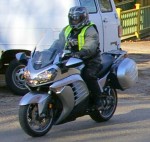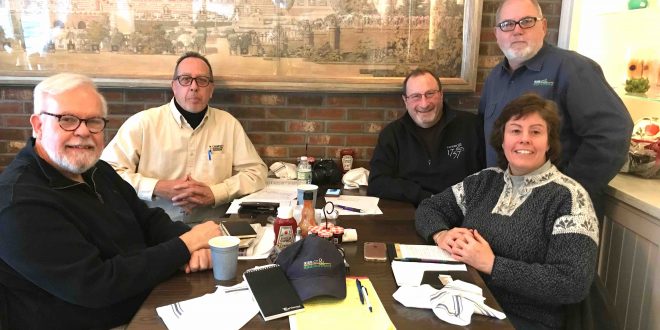A bill in the Connecticut General Assembly that would make lane splitting legal for riders has generated a lot of debate in recent days. The only state that makes the practice legal currently is California, where a study in 2014 revealed that it is no more dangerous than normal riding. There are valid arguments on the both of the issue.
While many readers have waded in on the subject on this website and on many Facebook pages where the story was shared, RIDE-CT & RIDE-NewEngland has been silent on the issue – until now. And a new Staff Inflection reveals that the staff is divided…
Steve Smith/Safe Riding
Lane splitting is a polarizing subject. A widely-accepted practice in Europe and Asia, it helps to ease traffic congestion and improve traffic flow, and allow it to happen without incident. The added benefits to riders is that getting the riders out of traffic lessens the likelihood of  being struck from behind and prevents engine overheating.
being struck from behind and prevents engine overheating.
The success of lane splitting elsewhere demonstrates the value. Since the bill was announced there have been polarized reactions with some comments pointing out the risk that others will not change their driving habits to accommodate the new law or, worse, will engage in road rage due to jealousy that two-wheel vehicles are allowed to filter through traffic.
The beauty of passing this bill to make filtering/lane splitting legal is that it would provide another tool riders can choose to use or not when interacting with traffic.
Paul Siciliano/Always Riding
I am not in support of such a bill here in CT. Even though I’ve split lanes myself, I am now less likely to do so, if at all.
 As someone who rides anywhere from 12k to 23K miles annually, I believe aggressive driving is out of control, and will soon be more problematic than distracted driving. To propose that you can sway the public to sit in their cage in stopped traffic and cooperate while a motorcyclist splits the lane is just not realistic.
As someone who rides anywhere from 12k to 23K miles annually, I believe aggressive driving is out of control, and will soon be more problematic than distracted driving. To propose that you can sway the public to sit in their cage in stopped traffic and cooperate while a motorcyclist splits the lane is just not realistic.
I have had doors opened on me, cars nosed over in my path, and even powered truck mirrors extended to obstruct me as I have tried to split a lane at crawling speed to get to the shoulder.
Connecticut drivers won’t even stop at a white line at an intersection or a stop sign. These drivers display an entitlement in their driving actions and seem to have zero consideration for a motorcyclist.
Until the laws we all know like stopping at a stop sign, speeding, yielding are enforced, I just cannot see how you can open the door for more cases of “I didn’t see them.”
Bob Rosen/Dealer Perspective
Nice to see that CT is going to consider the idea of making lane splitting a legal activity. I’ve seen the benefit of this solution to congestion first-hand in Europe. I can still remember looking down from my third floor Milan hotel room and watching hordes of scooters (and some  bikes) pass through traffic like swiftly flowing water around rocks in a stream.
bikes) pass through traffic like swiftly flowing water around rocks in a stream.
Of course, in Europe this is a practice accepted by all – including the four wheeled population. In order to keep problems to a minimum, it’s important that all of the motoring folks cooperate to some extent.
My own experience with lane splitting includes many instances of (illegally) gliding by stopped or nearly-stopped traffic as I made my way towards one of the bridges linking the Bronx to Queens. Depending on the time of day, things can get pretty tough as you approach the Throgs Neck or Whitestone bridges. Lane splitting has saved me a lot of time over the years.
I’ve also seen riders scream through stopped traffic at rates of speed that I find downright frightening. It’s usually the “wild ones” on their super sports bikes that seem to have a death wish. I can only imagine what the folks stuck in their cars have to say about that show!
No doubt my own, more relaxed, approach has led to a few comments as well. Here’s hoping the eastern states follow California’s lead and adopt a sensible lane splitting law. Having the law stipulate maximum filtering speeds will be an important part of any rules that are created.
As with most laws, the success will mostly come from the riding community properly following the guidelines as opposed to rigorous enforcement.
Victoria Zandonella/Off The Beaten Path
Due to the culture of overly-aggressive driving here in the Northeast, coupled with a good dose of road rage cases, I personally am not an advocate of lane splitting in this region. I commute on I-84 every day and see a lot of distracted drivers – texting while driving over the  posted speed limits at rush hour.
posted speed limits at rush hour.
I also have witnessed some harrowing cases of road rage and have even been victim to a few myself over the years. I can only cringe at how, if this legislation is passed, this will turn out for a rider who does not have the benefit of a cage to protect them from all of this while legally lane splitting. While the law is on their side, the chance of disablement, or even death, in the face of being within the bounds of the law to lane split is a bad trade off in my opinion.
Some say it’s safer than standing in traffic waiting for a distracted driver to plow you into the car ahead, others say it reduces congestion, and avoids overheating of air-cooled engines while also saving a rider some time in their travels. All points in favor of the issue in addition to the success lane splitting has enjoyed in other areas of the U.S. But do these benefits outweigh the risks here – in this neurotic, fast-paced corner of the country?
Arlo Mudgett/Hill Country
I am in favor of lane splitting for a bunch of reasons. If you’ve ever driven a rush hour commute in California, you know true frustration. I once drove from Santa Rosa in Sonoma County down to Oakland. It was slow, frustrating, but about as orderly and mellow a rush hour as  I’ve ever seen. There were plenty of lane splitting motorcyclists. They were all respectful and weren’t abusing the privilege. It just seemed to work.
I’ve ever seen. There were plenty of lane splitting motorcyclists. They were all respectful and weren’t abusing the privilege. It just seemed to work.
I’ve also lane split in New England. One day about 24 years ago, I left Lubec, ME around 6:20 a.m. It was during a July heat wave and somewhere past Portand I suddenly came upon miles upon miles of pure gridlock. I-95 was under construction and it was a mess. There was no way that I was going to survive that without an overheated engine or a million stops and restarts, and I had no intention of beating up my bike like that, so I illegally lane split until the next exit and went cross-country over to the Lakes Region of NH and home.
Only a small minority of people got angry, but they were really angry about it. One guy opened his drivers door on me but I was able to avoid hitting it. Others swore and yelled at me, shaking their fists, but I just ignored them. I made it home and saved a lot of fuel and hassle by lane splitting on I-95 for a few miles. It proved to me what a fine commuting tool a motorcycle can be if only we were allowed.
I’m all for lane splitting – legally.
Tim Raindle/Contributor
I have to say that I am pleasantly surprised to learn that lane-splitting – or “filtering” as it is known in the UK – may be made legal in Connecticut.
 As someone who learned to ride through heavy London traffic, it comes naturally as part of riding a motorcycle. In most urban areas of Europe, the ability to overtake lanes of slow moving or stationary traffic on two wheels is an essential freedom. It is something that is not only taught in rider training courses, but is covered in “Roadcraft,” the British police rider training booklet.
As someone who learned to ride through heavy London traffic, it comes naturally as part of riding a motorcycle. In most urban areas of Europe, the ability to overtake lanes of slow moving or stationary traffic on two wheels is an essential freedom. It is something that is not only taught in rider training courses, but is covered in “Roadcraft,” the British police rider training booklet.
I would , however, urge riders to exercise extreme caution and vigilance if it becomes law. A summer reacquainting myself with riding on congested European roads has been thoroughly enjoyable, but has also made me aware that car drivers there are quite considerate of motorcyclists, and are taught to “think bike.”
In England, drivers are accustomed to being passed by motorcycles, and many areas of high bike usage have signs reminding drivers to watch out for riders. Drivers will often adjust their lane position slightly to give you more room, and let you know that they know you are there. In short, they are trained to expect it.
I remember on my first visit to the US, not realizing that lane splitting was illegal, I was caught in a 10-mile tailback on Cape Cod. It was natural for me to ride carefully down the middle of stationary cars, but I could see as I passed cars that many drivers were actually shocked. Some even shouted and shook their fists.
If the bill passes, it will be up to us as riders to help educate the guys and gals stuck in cages, and ensure that the new law is eased into life with a trouble-free progress. A safe and successful introduction may not only encourage other states to follow suit, but may also lead to further motorcycle-friendly legislation being passed in the future.
Bud Wilkinson/RIDE-NewEngland
Having been in situations where my motorcycle could easily have overheated, and having been tempted to lane split illegally on occasion, I  tilt hard toward making it legal. The upside far outweighs the risks, which can be minimized over time.
tilt hard toward making it legal. The upside far outweighs the risks, which can be minimized over time.
My only caveat is find a way to make other motorists aware that riders who do so aren’t being jerks, rather they are doing what is permitted. Overhead sign boards on the Interstates displaying the illuminated message that “Lane Splitting Is Legal” would just be a start.
 Ride CT & Ride New England Serving New England, NYC and The Hudson Valley!
Ride CT & Ride New England Serving New England, NYC and The Hudson Valley!



I learned to ride a motorcycle in New England and moved to Southern California. I can say that learning to share the lane is not an easy task at first. It took me about 4 months to become somewhat comfortable and another year to feel confident. Keep in mind that this was done in a place where motorist expect you to do it and they regularly make room for you to shimmy your way through even when you are not trying to.
Don’t mistake my words for those of someone opposed to the idea. I loved lane sharing and miss it a bunch. There will be a learning curve for both riders and drivers. Once we are all acclimated to the concept, it should prove to be a fantastic way to enjoy riding and alleviate traffic a bit.
I would like to see an article like this with the opinions of the general public included, not just the Motorcycle community.
We (the Motorcycle community) seem to be split in our opinion re: lane splitting and I would think the vehicles we will be mixed in with may have a completely different outlook on what will be happening around them.
At 60 yrs old and have been riding street bikes since I was a teen and toured through 41 states and 3 Canadian provinces and although I see the benefits I also see it as a dangerous practice and goes along with the “I am special and should get preferential treatment” just because I ride a Motorcycle.
I’m on the fence really I think it should be an option we could use but not abused. Why jump to the front of the line just because you can. But in the same instance why sit in traffic congestion when there is a safe way for a rider to go.